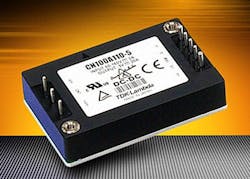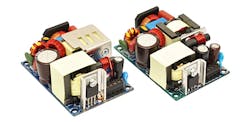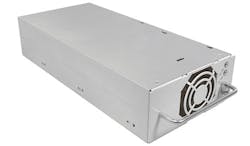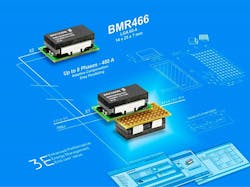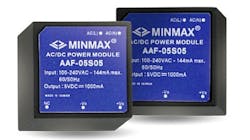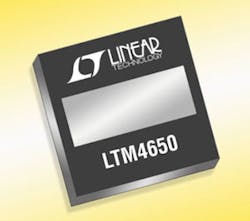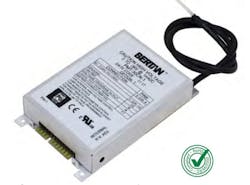Power Management, Chapter 4: Power Supply Packages
This articles is part of the Power Management Series in the Power Management section of our Series Library.
Download this article as a .PDF eBook.
Power-supply packages will influence the performance, cost, and size of the power supply used in the power-management subsystem. Therefore, the selection process for purchasing a power supply should take the package style into account. Package styles can range from the open-frame type without an enclosure to the completely enclosed type, like the standard brick.
The quest for multiple source dc-dc converter modules has led to a family of standard “brick” sizes. There are now “16th-brick” and “eighth-brick” sizes to go along with the full-bricks, half-bricks, and quarter-bricks. And, power densities have gone beyond 50W/in.3 Many of these modules are interchangeable with those of many manufacturers, which ensures multiple sources. In addition, pinouts of the brick converters are now a de facto standard, allowing interchangeability between different manufacturers’ products. Currently, distributed power architecture (DPA) system bricks can dissipate hundreds of watts. Table 4-1 lists the size for each of the brick sizes. Generally, the larger the size, the higher the maximum power output.
Modular brick dc-dc converters supplied by the front-end supply provide electrical isolation, increased load transient performance, and a modular upgrade path (Fig. 4-1). Their lower output voltage draws a larger current (for a given power level) and has less tolerance for deviations in its voltage caused by voltage drops on the lines between the converter output and its load.
4.1 Modular brick dc-dc converters supplied by the front-end supply provide electrical isolation, increased load transient performance, and a modular upgrade path.
There are also ac-dc bricks. Initially, these bricks required two modules. One module for the ac input rectification and power factor correction (PFC), and another for the dc-dc isolation and low voltage conversion. Now, these two functions are available in a single brick, thus eliminating module interconnects and saving 25% or more printed circuit board space.
An example of a single module ac-dc brick with PFC is TDK-Lambda’s 1000W PFE1000F series that is available with 12V, 28V, and 48V nominal outputs that are adjustable to ±20%. The series can operate with a baseplate temperature range from -40°C up to +100°C. Line and load regulation is 0.4% max and efficiency is in the range of 82% to 86% depending on output voltage.
These models accept an 85Vac to 265Vac input at 47-63Hz and have active power-factor correction (PFC), an input-to-output isolation of 3kVAC, and an input-to-baseplate rating of 2.5kVAC with application circuitry. In addition, overvoltage, overcurrent, and overtemperature protections are included.
The PFE1000F comes in a 6.3 × 3.94 × 0.53-in. package that is larger than a dc-dc full-brick, but its construction resembles its dc-dc cousins. Other members of the PFE series are rated at 300W, 500W, and 700W and are housed in a full-brick package the same size as the dc-dc full-brick. These full-brick ac-dc supplies also have PFC.
An advantage of the DPA approach with multiple dc-dc converter brick modules is that the heat produced by each of the modules is spread throughout a system. In contrast, most of the heat associated with a centralized power system is in the single power supply.
4-2. Gresham Power Electronics’ (M)WLP75 AC/DC converter. This open-frame series is the fourth addition to the EOS low-profile, high-efficiency (M)WLP series. Available in medical and industrial versions, (M)WLP75 features include: 75W convection rating; efficiencies up to 93%; -40 to 70°C operation; standby power < 0.3 Watt; weight 150g; dual fusing; and Class II Option available for medical applications and RoHS compliance.
Use of a dc bus voltage, typically 48V, also means cables with lower current are bused throughout the system. Higher current requirements are handled by the dc-dc converter modules that are located close to their loads, which minimizes distribution losses and enables smaller, less expensive conductors to be used for the cables that bus the secondary voltage.
From a reliability standpoint, each element in a DPA has its own power supply, so failure of a single dc-dc converter module will only affect a single function or printed circuit board, which aids the design of fault-tolerant systems.
DC-DC converter brick modules are a key ingredient in DPA systems. The performance of these converters is directly related to the IC operating voltage requirements that are dropping from the historic standard of 5V to 1.5V, with projections of less than 1.0V over the next decade. Besides the 5V and 3.3V outputs, some converters now provide 2.5V, 1.8V, and 1.2V, and some can supply 0.8V.
“Off-the-shelf” standard brick converters can lower system development costs and also shorten design cycles because if they have already been tested and are available from multiple sources. If the system’s powering requirements change, it is relatively simple to replace one converter module with another, that is, no major redesign is usually required.
The majority of packaged dc-dc converter brick modules are mounted on p.c. boards holding associated digital circuits. Therefore, the converter module’s size impacts a board’s circuit density. This includes the converter’s footprint area that determines how much circuitry can be placed on the board. Converter module height is also important because it affects spacing between boards within the system. Eliminating the need for a heat sink also allows tighter board-to-board spacing.
To operate without a heat sink and provide more power output, the brick dc-dc converter must be efficient, particularly at the new lower semiconductor operating voltages. Therefore, the converter must minimize its internal power loss and the operating temperature of its components. Achieving higher efficiency also reduces the system’s input power and cooling requirements. Plus, it influences system manufacturing and operating costs.
Minimizing internal power loss lowers the converter’s case temperature, which may eliminate the need to employ forced-air cooling. Most converters have maximum case temperature ratings less than 100°C.
One approach to reducing internal power loss and improving converter efficiency is to employ synchronous rectifiers consisting of power MOSFETs. This higher efficiency obtained by synchronous rectifiers means the converter dissipates less heat and may no longer require a heat sink.
Non-Brick Power Supplies
Non-brick dc-dc power supplies are available in both single- and multiple-output versions. They come in open-frame, such as these from Gresham Power Electronics (Fig. 4-2). Most of these modules deliver from 20W to 500W, which is somewhat less than their larger brick cousins. They may be rack-mounted, DIN-Rail mounted, or packaged within an electronic system. Some of these power supplies have a high enough isolation voltage to allow them to be certified for use in medical systems.
The physical size of these power supplies varies over a wide range, from a length of 0.65 in. to 21.2 in. Some packages employ SMT, DIP, or SIP connections, whereas some use through-hole pins and others use screw terminals.
Non-brick supplies with multiple outputs include those employed with Compact PCI systems that employ 5V, 3.3V, and ±12V.
4-3. Astrodyne’s modular 3.8 kW Mercury-Flex is hot-swappable, enabling maximum uptime. For applications that require higher power, you can connect the modules in parallel current sharing groups through a four-module shelf assembly. This enables designs of upwards to 228 kW in a single universal 19-in. rack (30U).
Astrodyne TDI digitally programmable ac/dc power supply provides 3,800 W of regulated power and can operate as either a current or voltage source up to 400 V or 170 A (Fig. 4-3). Intended for industrial applications that require a flexible, digitally controlled industrial power supply with a universal voltage range of 90 VAC to 264 VAC and a 50/60 Hz single-phase input, the Astrodyne TDI Mercury-Flex is offered in a variety of adjustable dc output voltage range models including 0-28V, 0-56V, 0-85V, 0-125V, and 0-400V. This reliable unit delivers efficiency up to 93%, with a power factor of 0.97 or better, helping to lower energy requirements and heat dissipation. Its 14 VDC auxiliary output is useful for powering miscellaneous user circuits.
4-4. CUI’s PFR-2100 is a 2,000 W front-end supply in an enclosed package.
CUI Inc.’s PFR-2100 is a 2000 W front-end ac-dc power supply in an enclosed package (Fig. 4-4). The PFR-2100 series is a blind-mate rectifier with a programmable output voltage range of 100~410 Vdc. Key features include a hot-swap blind-docking capability implemented through the use of a single connector that integrates ac, dc, and I/O signals. The PFR-2100 delivers high efficiency up to 93% in a package measuring 11.5 × 5.2 × 2.5 in. (292.1 × 132.08 × 63.5 mm). The series is ideally suited for use in data-center high-voltage dc bus power systems, broadcast amplifiers, and EV battery-charging systems.
The programmable dc output voltage delivers a constant current up to 5.125 A with droop current sharing for paralleling up to 12 units. Additional features include power-factor correction, remote on/off control, power good signal, and front-panel LED indicators. The PFR 2100 series complies with all applicable EMC requirements to accommodate worldwide applications and offers 60950-1 safety approvals. Protections for overvoltage, overcurrent, and overtemperature are also provided.
4-5. The BMR466’s unique LGA (Line Grid Array) footprint is 0.98 × 0.55 in. and has an exceptionally low profile of 0.276 in., which facilitates compact system design.
4-7. Aimtec’s 1 watt dc-dc converter series is available in a compact single-inline SIP4.
Supported input voltages of 3.3, 5, 12, 15, and 24VDC convert to single output voltages of 3.3, 5, 9, 12, 15, and 24VDC. Operating within an ambient temperature range of -40°C to +105°C (derating at 85°C), the Aimtec's AM1SS-NZ series is designed for versatility and can be integrated into a multitude of applications, such as digital circuits, low-frequency analog, or relay-drive circuits.
Available in a compact, single-inline SIP4 package (11.60 × 10.10 × 6.00 mm), the AM1SS-NZ is offered with an input-output isolation upgraded to 1500VDC for easy integration in industrial, telecommunication, and computer applications.
µModule
Power-supply packages continue to shrink by using semiconductor industry manufacturing techniques. The result is the μModule (power module) regulator that integrates switching controllers, power FETs, inductors, and all supporting components in a conventional ball-grid array (BGA) package (Fig. 4-8). The circuit requires only a few input and output capacitors.
4-8. The LTM4650 µModule is housed in a conventional ball-grid array (BGA) package.
The Linear Technology LTM4650 is a dual 25A or single 50A output switching mode step-down dc/dc converter. Operating from a 4.5V to 15V input, the LTM4650 supports two outputs each with an output voltage range of 0.6V to 1.8V, each set by a single external resistor. Its high efficiency design delivers up to 25A continuous current for each output. The LTM4650 is pin-compatible with the LTM4620 (dual 13A, single 26A) and the LTM4630 (dual 18A, single 36A).
4-9. Phihong’s energy-efficient 10W wall-mount adapter series is available in 5- and 9VDC outputs. The PSC12x Series consists of five versions: A, E, K, S, and C, each of which features a country-specific fixed-outlet plug. PSC12A adapters are equipped for use in the United States, Europe, United Kingdom, Australia, New Zealand, and China. PSC12x Series adapters are rated for operation from 0ºC to +40ºC.
This μModule supports frequency synchronization, multiphase operation, burst-mode operation and output voltage tracking for supply-rail sequencing and has an onboard temperature diode for device-temperature monitoring. High switching frequency and a current-mode architecture enable a very fast transient response to line and load changes without sacrificing stability. Fault protection features include overvoltage and overcurrent protection.
The LTM4650 is housed in a 16mm × 16mm × 5.01mm BGA package.
AC Adapters
AC adapters are a cost-effective and relatively fast way to provide a power source for computer peripherals such as these from Phihong (Fig. 4-10). There are two types of dc output adapters: linear and switch-mode. The switch-mode adapter provides greater efficiency and smaller size, whereas the linear power supply adapter is less efficient and larger, but could be “quieter,” that is, less radiated or conducted EMI. However, there are several adapters using the switch-mode topology that meet the FCC’s EMI requirements.
4-10. Spellman Bertan High-Voltage Power Supply PMT30CN-1features: 500V to 7.5kV @ 1.9 to 4 Watts; modular design; stability and regulation; low noise and ripple; arc and short-circuit protected; and CE listed, UL recognized and RoHS compliant.
It is important to obtain an adapter that has high efficiency, which minimizes heat dissipation, resulting in an adapter that is small and reliable. Without this high efficiency, the resulting internal temperature rise would be potentially hazardous and a major reliability limiter. In many applications, the adapter may be placed in a confined space, or it may be buried under a pile of cable, so minimizing heat is essential.
AC adapters are a cost-effective power source to charge portable system batteries because the OEM does not have to design and qualify the supply. Typically, these adapters can power the unit as well as charge the associated battery.
The switch-mode adapter provides greater efficiency and smaller size, whereas the linear power supply adapter is less efficient and larger, but produces less radiated or conducted EMI. A high efficiency adapter minimizes heat dissipation, resulting in a smaller and reliable unit.
The California Energy Commission approved new energy saving standards in order to slow down the demand for electricity throughout the state. According to the CEC, the energy savings from the new standards over the next 10 years will enable the state to avoid building three large power plants.
On average, ENERGY STAR-approved models are 35% more efficient than conventional designs, and often are lighter and smaller in size. Many adapters have safety approvals from cUL/UL, TUV, SAA, CE, C-Tick, and CCC (except for 48V). Some provide no-load power consumption of less than 0.5W, as well as low leakage current with a maximum of 0.25mA.
High-Voltage Power Supplies
High voltage ac-dc power supplies offer regulated outputs for bench top or OEM use (Fig. 4-11). Typical applications include: spectrometers, detectors, imaging, electron beam systems, projection television, X-ray systems, capacitor charging, laser systems, and cathode-ray tubes.
Available high-voltage ac-dc power supplies have many circuit and system variations. There are single-phase supplies with switch-selectable 115/230Vac, three-phase 208V inputs, and most include power-factor correction (PFC).
The method for generating the high voltage is either with a conventional switch-mode power converter, or a resonant high-frequency inverter.
Power-supply enclosures are usually fully metal-enclosed units, 19-in. enclosed metal rack panels, or smaller modules intended for embedded applications.
High-voltage power-supply outputs can range from 1kV to over 100kV, from fractions of a milliamp to amperes, and output power from watts to kilowatts. Output polarity may be a fixed positive voltage, fixed negative voltage, or a reversible positive or negative voltage output. The output interface may be a high-voltage connector, or a captive high-voltage cable. The output voltage adjustment may be provided by a local internal potentiometer, or a ground-referenced signal for remote operation. Output monitors on some units monitor voltage or current, or both. Output ripple is usually rated in peak-to-peak in mV or peak-to-peak as a percent of output voltage.
Most supplies offer protection against arcs or output short circuits. Among the miscellaneous features found in these supplies are local and remote programming, fault indicators with safety interlock, overload protection, and an enable voltage signal input for remote control.
Read more articles from the Power Management Series in the Power Management section of our Series Library.
Related Articles
1. Mario Battello, Rectifier ICs and Thermal Packaging Enhance SMPS, powerelectronics.com, May 2006.
2. John Mookken, Modular Approach Simplifies Power-System Design, powerelectronics.com, May 2006.
3. Lily Hsiu-shih Chu, Better Power Packages Make Better Circuits, powerelectronics.com, May 2007.
6. Sam Davis, 25 A POL Regulator Shrinks PCB Size by 20%, powerelectronics.com, May 2013.
8. Sam Davis, Ultra-Small Packages Shrink Power Management ICs, powerelectronics.com, November 2013.
9. Gary Gill, New Thermal Design Options Drive Power Density, powerelectronics.com, August 2013.
10. Jason Sun, Optimizing Power Supply Adapter Design, powerelectronics.com, July 2010.

